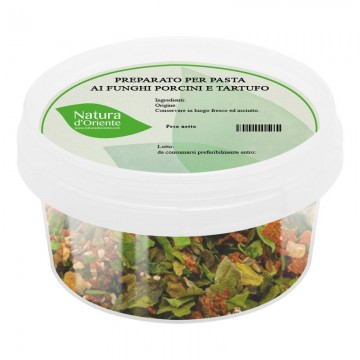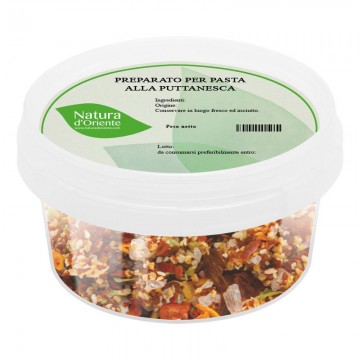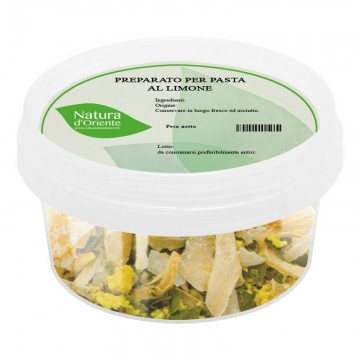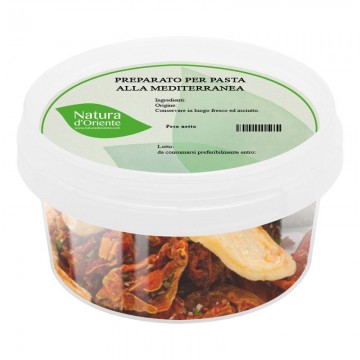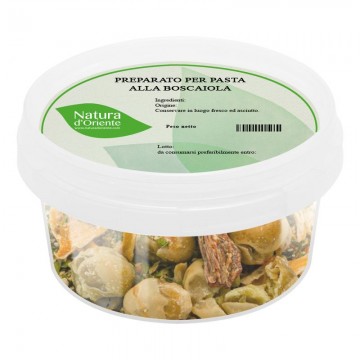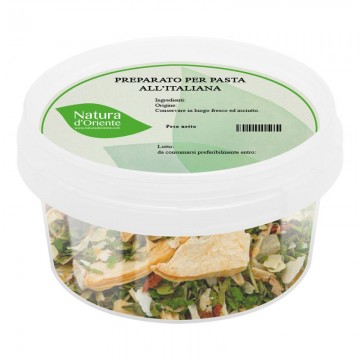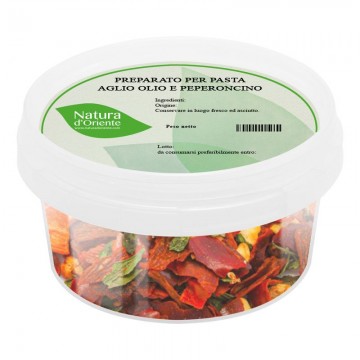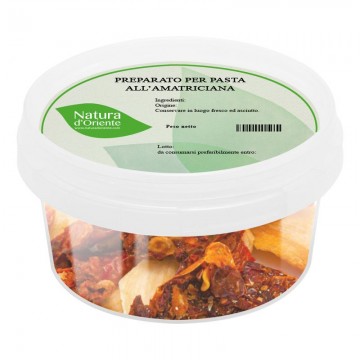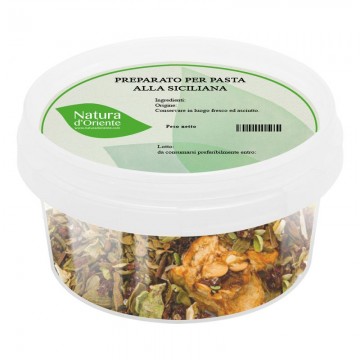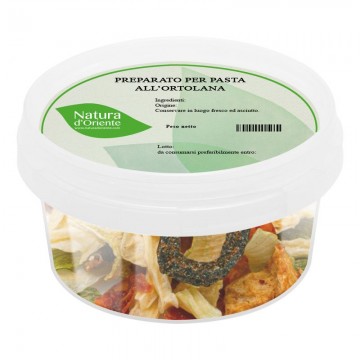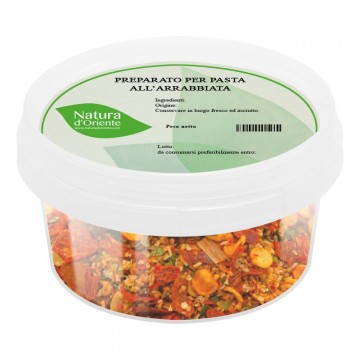Genoese pesto is probably the most famous pasta sauce in the world. The typical green condiment based on basil and pine nuts has conquered the world thanks to skilful marketing.
How to use our pasta mix inspired by Genoese pesto
Pour three teaspoons of product into a pan with extra virgin olive oil and fry for a few minutes, stirring frequently. Cook the pasta (preferably long), once ready, drain and toss in the pan with the sauce obtained. Serve piping hot with a sprinkling of Parmesan.
History of Genoese pesto
When we talk about the history of pesto alla genovese we need to distinguish between the birth of pesto proper and historical roots that can be identified. The pesto recipe is quite recent, it dates back to the second half of the 1800s at the latest, the first written mention is in the cookbook "La cuciniera genovese" whose first edition by Giovanni Ratto dates back to 1863. In 1910 Emerico Romano Calvetti gives a his version of pesto calling it "battuta (or savore) of garlic" thus confirming the theories that see in aglta (in Genoese aggiadda), a much older sauce based on garlic, vinegar and dried tomatoes, used to preserve dishes , the progenitor of pesto.
However, there are other less accredited theories, one is practically a legend that for a change would see as the inventor of pesto a friar of the convent of San Basilio (on the heights of Prà) who collected the basil, an aromatic plant that grew nearby and whose name would be in honor of the saint and combined it with the ingredients brought by the faithful.
Others see the origins of pesto even in Roman times and precisely in a variant of the moretum. Moretum was a cheese with herbs that is mentioned by Virgil in the Appendix Vergiliana, another Roman author Lucio Giunio Moderato Columella who wrote about agriculture in his De Re Rustica cites some alternative versions, including one with pine nuts.
The probable truth is that pesto alla genovese is a modern sauce which, however, is prepared with traditional ingredients of Ligurian cuisine found in the area since ancient times and therefore it is easy to succumb to the suggestion of locate in previous dressings of direct ancestors.
Probably the birth of pesto as we know it is also due to a change in the taste of consumers, for whom the oldest sauces, all characterized by the strong presence of 'garlic.
The recipes of Genoese pesto
The generally accepted traditional recipe consists of seven ingredients: basil, extra virgin olive oil, pine nuts, Parmesan cheese, pecorino, garlic and coarse salt. For purists, the basil should be that of the Prà hills, the Sardinian pecorino, the strictly Italian pine nuts. In reality, when the recipe was born, it seems difficult to imagine that Ligurian shepherds had Sardinian pecorino and even less expensive Parmigiano Reggiano at their disposal. The proportion between the two cheeses can vary, from 50 to 50% until there is only one left.
On the other hand, what might surprise some is that in the production regulations of the Genoese pesto consortium, walnuts are allowed to be placed side by side with pine nuts, in respect of the tradition in which they often completely replaced pine nuts which were an expensive and not easy to find ingredient.
The processing method of the ingredients is as important as their quality, first of all we are talking about pesto, not sauce, that is, a condiment prepared completely raw, this allows you to better preserve the organoleptic characteristics of the ingredients. In the artisanal preparation methods the pesto is pounded in a mortar, for obvious reasons industrially it is instead blended, the first method is certainly preferable because in the blender the blades heat up and can change the flavor of the ingredients. At an industrial level, technologies will probably have been implemented to avoid this, but if you prepare the pesto yourself at home: mortar and elbow grease!
Curiosities about Genoese pesto
According to many chefs, if it is true that there is less garlic in pesto than in agliata and other typical Ligurian medieval sauces, it is also true that eliminating it completely distorts the recipe, garlic is an essential element of Genoese pesto becauseits strong flavor serves to balance a recipe that would otherwise tend to be sweet.
Parmesan cheese was a recent addition to the ingredients, even in the first versions of pesto Dutch cheese was used, more easily available than Parmigiano Reggiano thanks to the commercial exchanges of the Genoese with the Dutch . Again in Giovanni Ratto's recipe that we mentioned earlier we read: "Take a clove of garlic, basil (baxaicö) or if you don't have this marjoram and parsley, Dutch cheese and grated Parmesan cheese [...]"
In the traditional recipe to prepare pesto in the mortar it is indicated to use coarse salt due to its hygroscopic action (ie the ability to absorb the water molecules present in the environment surrounding) which absorbs the vegetation water.
The Genoese sailors were fundamental in spreading pesto all over the world, previously the typical sauce they used was the aforementioned agliata, but for the reasons already mentioned it could not be destined to have the same universal success.

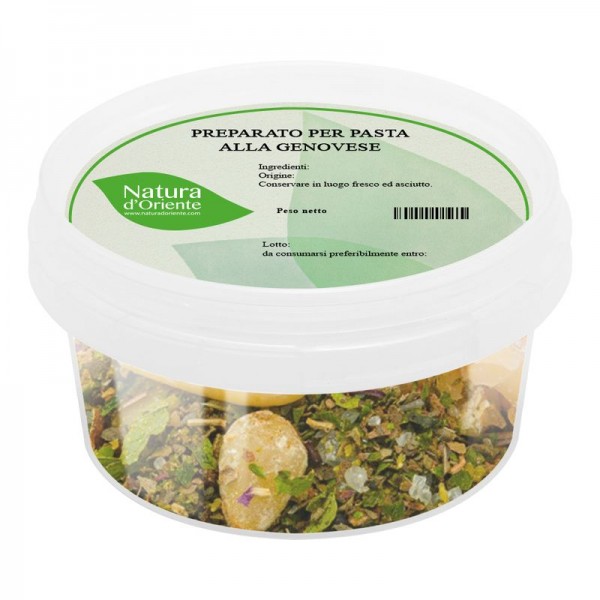



 No reward points for this product.
No reward points for this product.
